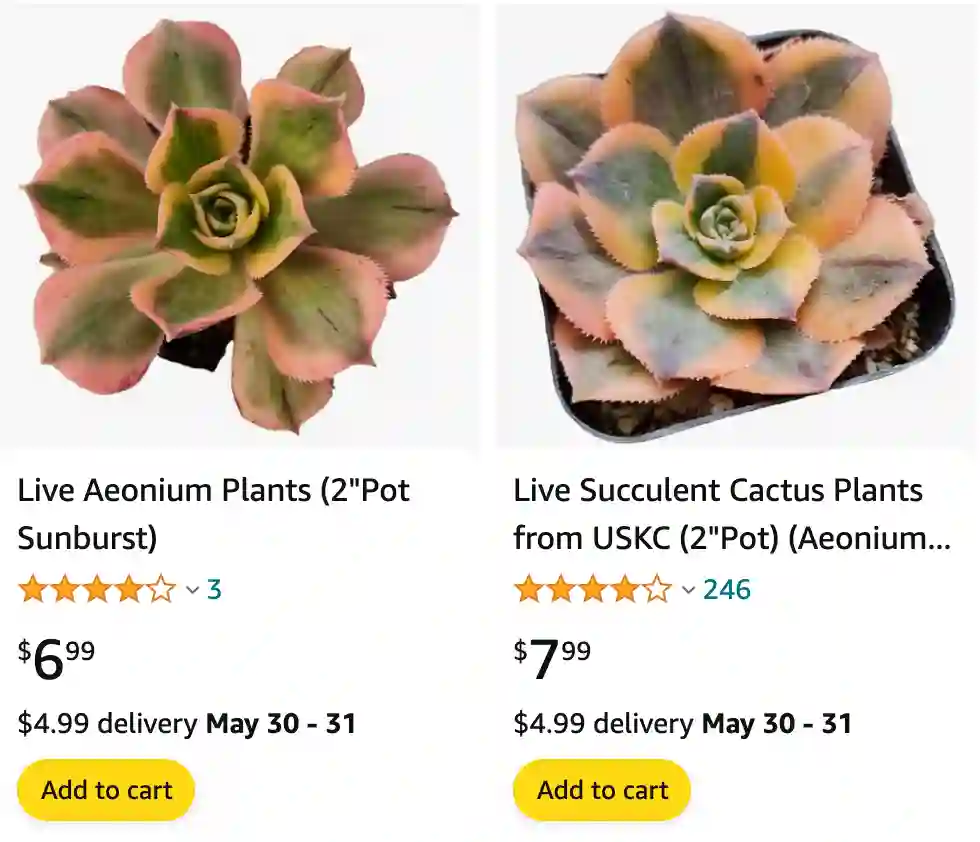
How to care for Aeonium Sunburst?
Here’s a helpful guide on caring for your Aeonium Sunburst, a stunning succulent with vibrant rosettes of yellow and green:
Light:
- Aeonium Sunburst thrives in full sun during the cooler seasons (early spring, fall, and winter).
- In hot summer months, provide partial shade or morning sun only, especially in scorching climates.
- Insufficient light can lead to stretched growth and less vibrant colors.
Watering:
- Water your Aeonium Sunburst using the soak and dry method. Allow the soil to dry out completely between waterings.
- Overwatering is a major threat, so err on the side of underwatering.
- When watering, soak the soil thoroughly until water drains from the drainage holes. Discard any excess water in the saucer to prevent root rot.
Soil and Potting:
- Use a well-draining succulent or cactus potting mix. You can also create your own mix using a combination of potting soil, perlite, and sand for optimal drainage.
- Ensure the pot has drainage holes to prevent waterlogging.
Temperature and Humidity:
- Aeonium Sunburst prefers warm temperatures between 60-80°F (15-27°C).
- It tolerates high temperatures but needs protection from scorching sun during the hottest part of summer.
- While it tolerates average household humidity, higher humidity levels can be beneficial.
Fertilizing:
- You don’t need to fertilize heavily. A balanced, diluted liquid fertilizer applied once during spring or early summer is sufficient.
- Avoid overfertilizing, which can lead to leggy growth.
Propagation:
- Aeonium Sunburst can be easily propagated by stem cuttings or leaf cuttings.
- Take stem or leaf cuttings in spring or summer and allow them to callous over before planting in a well-draining potting mix.
Repotting:
- Repot your Aeonium Sunburst only when the roots outgrow the current pot, typically every 2-3 years. Choose a pot that’s only slightly larger than the root ball.
Pests and Diseases:
- Aeonium Sunburst is generally pest and disease resistant. However, watch out for mealybugs and scale insects.
Additional Tips:
- You can deadhead spent blooms to encourage bushier growth and maintain a tidy appearance.
- Rotate your Aeonium Sunburst occasionally to ensure even growth on all sides.
- Aeonium Sunburst can tolerate some light frost, but it’s best to protect it from freezing temperatures, especially if young or recently planted.
How to propagate Aeonium Sunburst?
There are two main ways to propagate your Aeonium Sunburst: stem cuttings and leaf cuttings. Here’s a breakdown of both methods:
Propagation by Stem Cuttings:
- Selecting the Cutting: Choose a healthy, mature stem with at least a few sets of leaves. Ideally, it should be around 3-4 inches long.
- Making the Cut: Use sterilized pruning shears or a sharp knife to make a clean cut just below a leaf node (the bump where a leaf joins the stem).
- Callousing the Cutting: Allow the cut end of the stem to callous over for a few days. This helps prevent rot when planting. You can leave it on a dry, well-ventilated surface out of direct sunlight.
- Planting: Prepare a pot with well-draining succulent or cactus potting mix. Moisten the soil slightly. Make a small hole in the soil and insert the calloused end of the cutting.
- Aftercare: Water the soil lightly and place the pot in a location with bright, indirect sunlight. Avoid overwatering, and keep the soil mostly dry between waterings.
Propagation by Leaf Cuttings:
- Selecting the Leaf: Choose a healthy, plump leaf from the lower part of the plant.
- Removing the Leaf: Gently twist or pull the leaf downwards to remove it from the stem, taking care not to damage the leaf base.
- Callousing the Leaf: Allow the leaf to callous over for a few days, similar to stem cuttings. Lay it flat on a dry, well-ventilated surface out of direct sunlight.
- Planting: Prepare a pot with well-draining succulent or cactus potting mix. Moisten the soil slightly. You can lay the leaf flat on the soil surface or wedge the base of the leaf slightly into the soil.
- Aftercare: Water the soil very lightly and place the pot in a location with bright, indirect sunlight. Avoid overwatering, and mist the leaves occasionally to maintain humidity, especially in dry climates.
General Tips:
- Propagate your Aeonium Sunburst during the spring or summer growing season for best results.
- Maintain consistent warmth around the propagating plantlets.
- Be patient! It can take several weeks for roots to develop and new growth to appear.
- Once new growth emerges from the stem or leaf base, you can care for the new plantlet like a mature Aeonium Sunburst.
Where to buy Aeonium Sunburst?
Here are some ways you can find Aeonium Sunburst for purchase:
- Online plant retailers: Search online for reputable plant retailers that specialize in succulents or cacti. Many online stores offer Aeonium Sunburst and can deliver it to your doorstep.
- Local nurseries and garden centers: Call or visit your local nurseries and garden centers to see if they carry Aeonium Sunburst.
- Plant swap events or gardening clubs: Attending plant swap events or joining gardening clubs can be a great way to find rare or unusual plants like Aeonium Sunburst. You can trade cuttings or plants with other enthusiasts.
Here are some additional tips for finding Aeonium Sunburst:
- Use search terms like “Aeonium Sunburst for sale” or “buy Aeonium Sunburst online.”
- Read reviews before ordering from an online retailer.
- Consider the shipping costs when purchasing online.
- Look for healthy plants with vibrant colors and no signs of pests or diseases.




